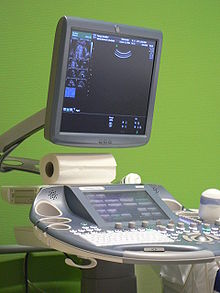Ultrasound
![]()
The title of this article is ambiguous. For other meanings, see Ultrasound (disambiguation).
Ultrasound is sound with frequencies above the human hearing frequency range. It includes frequencies from 20 kHz to 10 GHz; sound above this limit is called hypersonic.
Sound with frequencies below the human hearing threshold, i.e. <16 Hz, is infrasound.
Colloquially, "ultrasound" also refers to sonography, an imaging examination procedure in medicine.
In gases and liquids, ultrasound propagates mainly as a longitudinal wave. In solids, transverse waves can also propagate due to possible shear stresses. The transition from airborne sound to solids or liquids (or vice versa) is only possible to a limited extent due to the different sound impedances.
Depending on the material of an obstacle, ultrasound is reflected, absorbed, scattered or passes through (transmission). As with other waves, refraction, diffraction and interference also occur.
Air exhibits an attenuation for ultrasound that increases strongly with frequency. In liquids, on the other hand, ultrasound propagates with little attenuation. At high sound pressures, however, vapour bubbles are formed (cavitation), which can cause extremely high pressures and temperatures when they collapse. At frequencies between 2 and 20 MHz, cavitation occurs in pure, degassed water only above a sound pressure of 15 MPa. Cavitation is used, for example, for ultrasonic cleaning and is also the subject of current research (sonoluminescence).

Ultrasonic echograph or sonograph
Generation and registration of ultrasonic waves
Dynamic and electrostatic loudspeakers are suitable for generating ultrasound in air, as are piezoelectric loudspeakers in particular, i.e. membrane-coupled plates made of piezoelectric ceramics which are excited to vibrate by reversing the piezoelectric effect. Piezoelectric plastics (PVDF) can also be used to directly drive membranes, which results in improved transmission behavior.
Ultrasound in liquids and solids was initially generated only with magnetostrictive transducers (the first echo sounders worked in this way). Today, piezoelectric quartz or ceramic transducers are increasingly used. An alternating voltage with their natural resonance frequency (or a harmonic thereof) is applied to them. The oscillations are then transmitted, e.g. via the bottom of an ultrasonic bath, into the liquid.
Not too high frequency ultrasound can also be generated by galton whistles.
In principle, ultrasonic waves can be received using the same electrical transducers as are used to generate them.
To make bat calls audible, there are bat detectors that record the calls with a microphone, shift the frequency range of the calls that are in the ultrasonic range into the audible range, and play back these signals through a speaker or headphones.

Echo transit time behavior of ultrasound
Applications
Ultrasound has various applications in technology and medicine:
- Time-of-flight measurement of emitted ultrasonic pulses:
- Sonar, echo sounder: Depth measurement and seabed survey from water and underwater vehicles, fish finder.
- Early rangefinders (in air), such as for autofocus lenses (Polaroid)
- non-contact level measurement
- Sonography and echocardiography for the examination of humans and animals
- Parking aids, distance warning
- Underwater direction finder for flight recorders
- Exploitation of the Doppler effect:
- Measurement of wind speed with ultrasonic anemometer
- Ultrasonic flow sensor for pipes and ducts
- Motion detector
- Measurement of blood flow velocity by Doppler effect
- Ultrasonic density measurement
- Material processing:
- Ultrasonic vibrating lobe
- Ultrasound cleaning
- Ultrasonic welding
- Ultrasonic cutting
- Fiber digestion
- Ultrasonic microscope
- Ultrasonic motors / drives
- Contactless handling with ultrasound
- Information processing and transmission
- Early remote controls (late 1950s to about the mid-1970s) for television sets.
- Acoustic delay lines for signal delay in electronic circuits
- Surface acoustic wave filters, sensors, ceramic transducers, oscillating crystals
- Materials testing and structural investigations:
- Ultrasonic testing devices: unwanted inclusions, blowholes or cracks can be detected via reflections at discontinuity points of the density and their signal propagation time
- Coating thickness measurement, also on non-metallic substrates and with multi-layer systems
- Ultrasound therapy
- Ultrasonic cell disruption, production of protein crude extracts from microbiological samples (mainly bacteria, both in research and industry) by ultrasound, as the sound waves lead to lysis of the cell wall
- High-intensity focused ultrasound: ulcer treatment, stone disintegration (lithotripsy)
- Removal of tartar through water-cooled, high-frequency oscillating metal tip
- Ultrasonic nebulizers: atomizing, nebulizing, emulsifying, dispersing and mixing of liquids (for example in air humidifiers, fog machines)
- Degassing of liquids
- Acousto-optic modulators (AOM)
- Determination of the sound velocity of liquids using the Debye-Sears effect
- Devices for deterring martens (marten repellent) and other animals that are supposed to flee from ultrasound
- Dog whistles
- Communication with bats and dolphins for research purposes
- Recording of ultrasonic vocalization in rats and mice is used in psychopharmacological research as well as in neurobehavioral research.
- Double sheet control with ultrasound in printing technology
- Apparative cosmetics: micromassage and regeneration of the skin and introduction of cosmetic active ingredients (sonophoresis / phonophoresis)

Ultrasonic delay line (running time 64 µs) of a PAL or SECAM colour television (until approx. 1995); left open, right mode of operation and sound path
Search within the encyclopedia